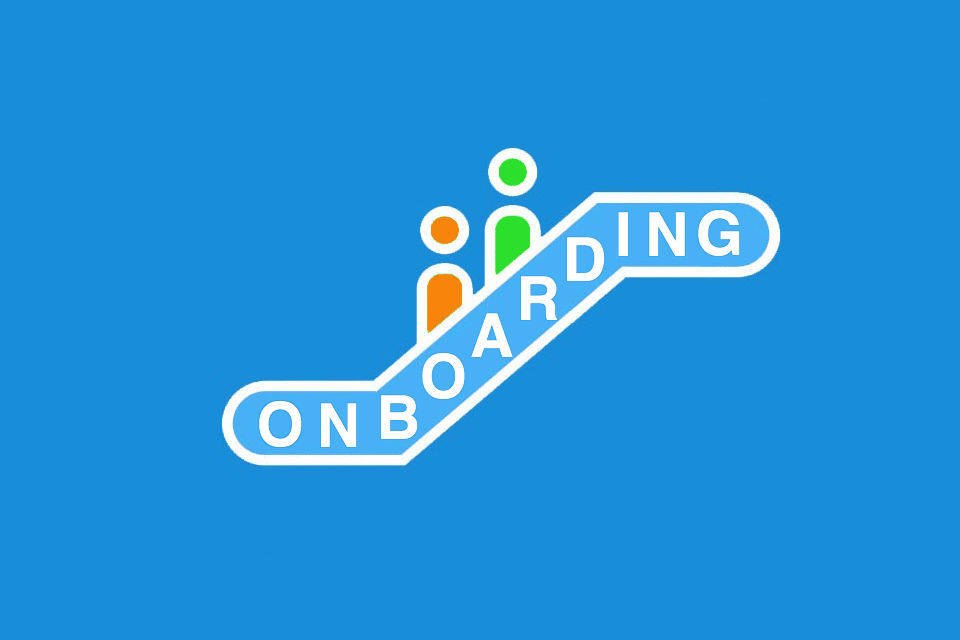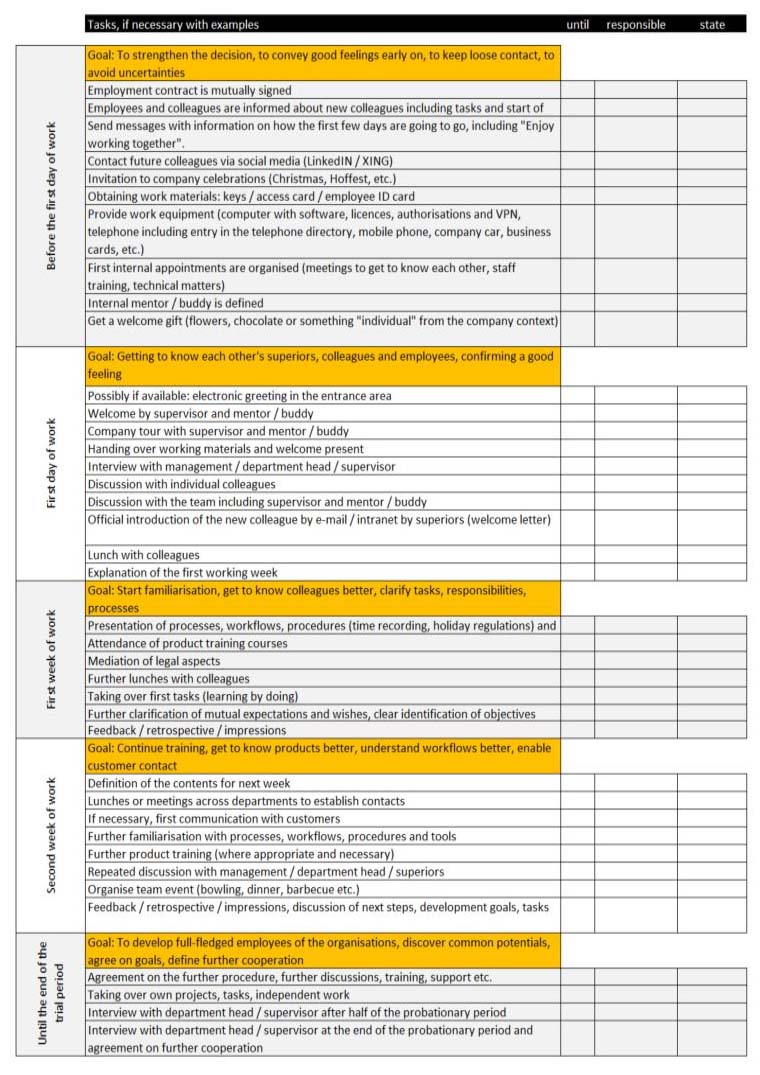What is Onboarding?
Table of Contents: Definition – Phases – Types – Tips – Questions from the field – Download – Notes
Onboarding definition
How do you feel when you turn up for your first day at your new company and your new line manager is surprised that you are starting today, but no workstation has been set up yet and no work materials are available? Obviously something has not gone ideally. Onboarding is the process of welcoming and integrating new employees into an organisation. The figurative expression “taking someone on board” means “taking someone on board”.
Why is onboarding important? The employer wants to enable the new employee to work productively as quickly as possible. At the same time, he wants to find out whether he has made the right choice with the employee and, if so, would like to keep him as such. The new employee also wants to know whether he has chosen the right employer, whether the cohesion in the company corresponds to the advertising promises and whether he would like to maintain the employment relationship beyond an agreed probationary period.
Phases during onboarding
Onboarding is usually divided into three phases:
- Preboarding is the period between signing the contract and the first working day. In practice, it can be observed in companies that this classic view is giving way to a more progessive one, according to which onboarding is already part of the application process.
- In the orientation phase – often in the first two weeks of work – the new employee gets to know colleagues, superiors and processes. The aim is to organise familiarisation and lay the foundation for integration.
- The actual induction of a new employee takes place in the third phase – meaningfully called integration. This is about coordinating expectations and gradually increasing the employee’s productivity in order to ideally make a mutually positive decision for continued cooperation after the agreed probationary period.
Types of onboarding
Four different types can be distinguished:
- Formal onboarding addresses organisational aspects, e.g. workstation equipment, access authorisations, mail access, business cards etc.
- Specialist onboarding includes the induction of new employees, the provision of information about the organisation, workflows, rules or meetings, as well as the acquisition of specialist knowledge.
- Social onboarding focuses on contacts with colleagues, superiors, customers and the exchange with these contacts.
- Cultural onboarding is about visions, values and principles of the organisation. Although it is advisable to communicate values and principles at an early stage, cultural onboarding is often a medium-term process, as there is a continuous comparison of communicated and lived values.
Tips for successful onboarding
There are a number of measures and tips that are helpful.
Before the first working day (in preboarding):
Before their first day at work, future employees often ask themselves whether the decision for the new employer was the right one. This uncertainty becomes greater the more time elapses between signing the contract and starting work. This is where small gestures of appreciation can give new employees a good feeling. A small note, a written greeting via e-mail or an invitation to a company party before the first working day encourages the decision to start with the company. These attentions can come from superiors or colleagues and should of course be meant seriously.
Here you can find more tips on preboarding:
- Explicitly name a contact person for questions before the start of the cooperation.
- Create a welcome folder or letter of welcome with useful tips about the city, some information about your company and a rough plan for the onboarding process.
- Offer help with organisational issues such as relocation.
- Keep active contact yourself before the first day at work and thus encourage the new employee’s decision in favour of your company.
- Invite the new employee to parties.
- Refrain from invitations to training courses that take place before the first day of work.
- If available, provide access to onboarding software.
On the first working day and in the first two weeks (orientation phase):
- Show that you are looking forward to working together. A bouquet of flowers, a bar of chocolate, a small message at the new workplace, a greeting from the supervisor, colleagues and, if applicable, the management, gives new employees the feeling of being welcome. Some organisations also have good experiences with a Welcome Day – an introductory event.
- Provide the necessary work equipment. This point sounds very simple in theory, but in practice it causes a lot of trouble for many organisations. It is not enough to provide a laptop if it cannot dial into the network, if programmes and access rights are missing. It is not enough if the telephone has not been activated with the correct settings in the telephone system. Missing business cards or business cards with the wrong job description or a wrong title are also not ideal. And what about a company ID card, access authorisations or keys?
- Introducing colleagues with their tasks, explaining important procedures in the first few days and naming contact persons makes it easier to get to know each other and to start working in the company.
- Appoint a mentor or buddy. This person “takes care” of the new employee, answers questions, establishes contacts with other colleagues and helps to master initial challenges. Enable an easy and continuous exchange between buddy and new employee.
- There is also the possibility of offering a coach as support.
- Discuss an induction plan with the new employee. Agree on measures to build up skills, discuss expectations, set goals, define stations in other departments, arrange regular feedback sessions, etc.
- Communicate the familiarisation plan to the team. In this way, everyone involved knows early on where they stand and what they can expect.
Time and again, it is recommended to explain the values of the company. Apart from the fact that these should already be discussed when getting to know each other, it is not enough to mention values. Values must be exemplified, only then do they provide orientation and thus also help with onboarding.
In the integration phase:
In the integration phase, the actual, specialist training takes place. In principle, it makes sense to consider onboarding measures for different employee profiles. A trainee needs different measures and support than a manager, a sales employee needs different information than an employee on the assembly line, and in sector A different measures than in sector B may make sense.
The following general tips are useful:
- Actively support the new employee in building knowledge and skills. If the new employee is to learn from colleagues, allow them time to do so. For example, let them participate in webinars that you offer to customers. For example, you might want to use him or her in other departments to gain an impression of the work there and to better understand the context. Send him/her to events and conferences with colleagues. Allow him/her to participate in meetings and consider this as working time.
- The larger a company is, the more sense it makes to provide for extensive networking among employees.
- Conduct structured feedback discussions and retrospectives with the new employee, preferably in different constellations: with the team, the manager, the buddy and the HR department.
- Use the feedback or lessons learned to improve and enhance onboarding.
In addition, it helps the team and the new employees if, during a daily exchange, it is jointly considered at which points the new employees can be directly involved in the “actual” work – in addition to all familiarisation tasks.
Questions from the field
Here you will find some questions and answers from the field:
Who is responsible for onboarding?
In the narrow and more conventional sense it is the responsibility of the personnel management or the personnel department to accompany the process and all measures of the integration of new employees, e.g. to assign them to the workplace, to procure necessary working materials and to formulate first tasks in coordination with the superiors.
In a somewhat broader and more progressive sense, onboarding is the task of the entire company, and thus also of managers and colleagues, to support and promote the integration of new employees. In addition, it is a process that is also becoming increasingly important in areas such as project management or software development, as more and more people are working with external service providers who also need to be “on board”.
What are the differences between conventional and progressive onboarding?
In addition to the types mentioned, onboarding can also be divided into conventional and progressive aspects:
If onboarding is viewed progressively, the human factor moves more into focus and shifts the focus from fulfilling a task to working together as a team and between people. In this way, the loyalty of new employees to the company and their integration are promoted from the outset.
In the conventional sense, onboarding begins with the first working day of the new employee and usually ends with the expiry of an agreed trial period. In the progressive sense, onboarding can already be part of the application process. Organisations can
- show new employees the concrete workplace,
- organise meetings with the already active colleagues (and possibly also involve them in the selection process),
- name common working materials and, if necessary, even offer the selection of optional devices and programs.
Such an approach offers a number of advantages:
- Applicants know at an early stage where they will be working with whom and with what tools, and can use this information to make an informed decision.
- Colleagues know who to look forward to and who to work with in the future.
- And the company encourages the admission and integration of new employees at an early stage.
Another difference between conventional and progressive onboarding lies in the form of the employment relationship. Are we dealing with new permanent employees or temporary, external service providers such as project managers, software architects or software developers? In the case of a temporary collaboration, onboarding must take place much more quickly; fortunately, many service providers are familiar with the situation of quickly finding their way in a new working environment. This means that they know what to look out for and which tools, information and contacts are essential for their work.
How can new employees be integrated remotely?
- The provision of working materials such as a “configured” laptop including all necessary programs, access to files and information e.g. via VPN, network sharing etc.
- Proactive networking by colleagues using existing collaboration tools or social media platforms such as LinkedIN, Bluesky & Co.
- A regular telephone exchange between supervisor and the new employee.
- A continuous exchange between Buddy and the new employee.
- The exchange in the form of daily meetings – for example, every morning and every evening – and moderated networking also promotes integration. If those involved know with whom they are working, this cooperation is often easier.
- A clear induction plan with agreed milestones and goals, with short-term activities and medium-term tasks.
- The organisation of retrospectives and lessons learned sessions.
- And last but not least: feedback and thus an open exchange of ideas. What does the new employee want? Where are there uncertainties, where is potential for improvement, what works well, what could work even better in the future. Feedback is the basis for successful onboarding – offline and online. For the new employee, the organisation and future employees.
Which metrics help to measure success?
When is the integration of new employees a success? There are various metrics that companies use to check the success of measures for the acceptance and integration of employees and to recognise potential for improvement:
- Fluctuation rate during or at the end of the probationary period – also called early fluctuation
- The opposite of early fluctuation: the proportion or number of employees remaining after the probationary period
- Measuring the quality of the new employee in terms of performance and teamwork – known as quality of hire
- Duration until full performance – the so-called time to fully operative
- Duration until all necessary work equipment is available – also known as time to environmentally operative
- Number of training sessions during the probationary period
- Assessment of the cultural fit (cultural fit)
- Number of four-eye discussions
- employer branding
However, these onboarding KPIs should all be treated with caution. An employee may leave a company after the probationary period, even though the integration measures were good. The assessment of the time required to reach full performance is subjective.
How important is authenticity in onboarding?
Most companies want new employees to be able to perform the tasks for which they were hired as quickly as possible.
New employees want to understand the company and its culture, find their way as quickly as possible in a new environment with new colleagues and processes, and know what is expected of them.
For this to succeed in the long term, it is important to understand onboarding as a process. The process does not end on the first day of cooperation, but begins there at the latest. A joint exchange and the further development of the measures help to continuously improve onboarding. Authenticity is important here, because empty promises made via a website or in an interview are quickly noticed and do not contribute to the successful integration of new employees.
Which software supports the employee integration process?
Here you can find a small list of onboarding tools:
[1] Would you define budgets for integration measures?
[2] What could and should a new employee do to support the process of integration?
Notes:
In some publications, a correlation is found between the increase in productivity of employees in the integration phase and the decrease in the risk of dismissal. Whether this correlation actually exists may be questioned, but it is certainly not linear.
The opposite of onboarding is offboarding. In the context of external services, offboarding is relatively common and usually structurally regulated, but in the context of fluctuation it can become a challenge for companies.
Some companies define so-called reboarding processes for employees who change internally and take on other tasks or projects, or who return to the organisation after a longer absence – e.g. after parental leave or sabbatical.
There is another interpretation of onboarding; this addresses the use of online tools such as whiteboards in the course of online meetings or conferences and the setting up of projects. “Onboarding” stands for the simple learning of how to use the respective programmes or for the necessary basics in the course of successful project management.
Here you can find a German-language podcast with Gabriel Rath and Christiane Brandes-Visbeck about onboarding in the hybrid age.
Here you can download the Onboarding Guide for free.
If you like the article or would like to discuss it, please feel free to share it in your network. And if you have any comments, please do not hesitate to send us a message.
And here you can find additional information from our t2informatik Blog:




